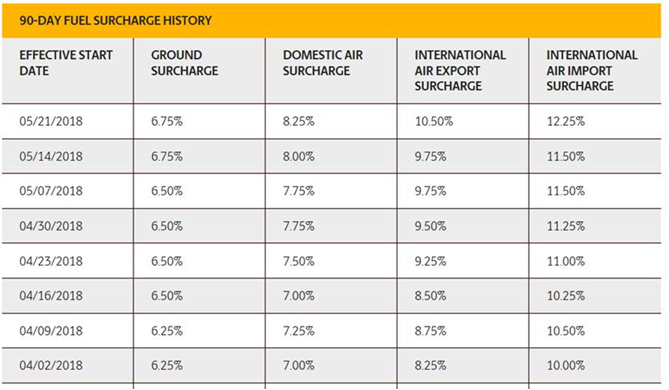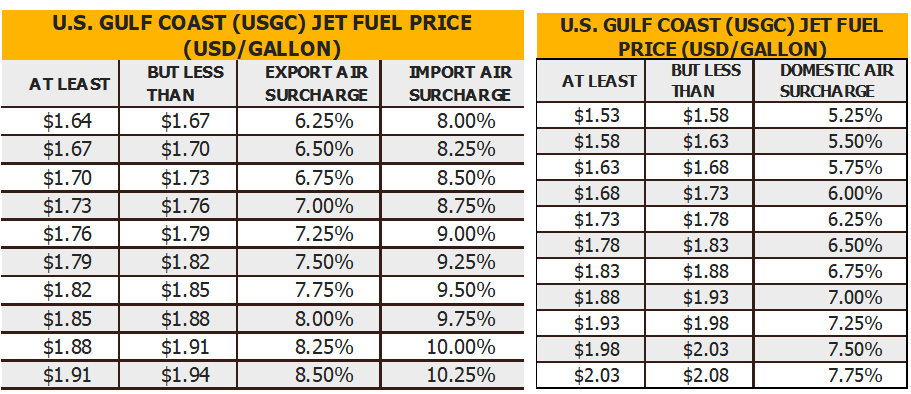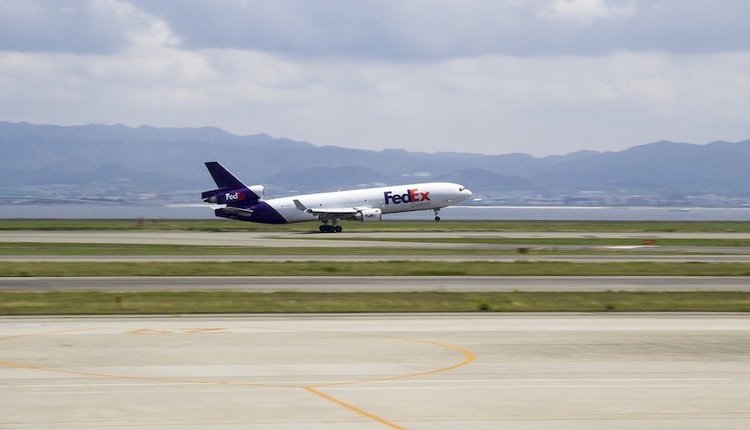We haven’t reached summer yet, but UPS has decided it’s never too early to start making rate changes. It has already changed its fuel surcharge tables for air export, effective the first week in April. On June 4, it is adding a fee for Shipping Charge Corrections (SCC) and increasing Over Maximum Limits and Oversized Pallet Handling charges again. Finally, as announced previously, UPS is increasing the Additional Handling Service (AHS) charge as well as Large Package Surcharge (LPS), effective July 8.
Collectively, these changes represent yet another major intra-year rate hike for many shippers, and they require additional explanation.
Fuel Surcharge Changes
In April, UPS split the fuel surcharges for Domestic Air and International Air Export. Export used to have the same fuel surcharge as domestic air. Import has been different for over a year. With this new logic, the export fuel surcharges are significantly higher, as illustrated below. This new fuel logic is an extra one to two percent on the cost of your export shipment.

To add to the complexity, the tables used to determine the air fuel surcharges are also different. They are both based on the DOE commodity index for US Gulf Coast Jet Fuel, but the bands are narrower for the international table. In other words, shippers will experience greater fluctuation in fuel costs for international packages. (See table below for details.)

Shipping Charge Corrections
Starting June 4, UPS is introducing an audit fee for Shipping Charge Corrections. This fee, the greater of $1.00 per adjusted package or six percent of adjusted revenue for the invoice week, will apply whenever the average shipping charge correction in an invoice week is more than $5.00.
Some of the triggers for shipping charge corrections are as follows:
- Incorrect or missing package dimensions resulting in additional surcharges (like AHS or LPS) with the updated dimensions;
- Incorrect or missing package dimensions resulting in corrected dimensional weight billed;
- Incorrect weight entered resulting in a reweigh or dimensional adjustment;
- Incorrect address manifested
One important fact about this charge is that it applies only if the average correction is greater than $5.00. Essentially, UPS is allowing mistakes to happen, but consistent and/or egregious errors will result in the penalty. See the below table for examples on when this fee would and would not apply.
# Corrections | $ Corrections | $ Per Correction | Audit Fee (Y/N) | Fee Amount | Fee Logic |
118 | $489.12 | $4.15 | N | N/A | N/A |
25 | $363.25 | $14.53 | Y | $25.00 | $1 per correction |
5 | $206.74 | $41.35 | Y | $12.40 | 6% of revenue |
201 | $947.82 | $4.72 | N | N/A | N/A |
98 | $490.52 | $5.01 | Y | $98.00 | $1 per correction |
Over Maximum Limits & Oversize Pallet Handling Surcharges
But wait, there’s more! UPS is also increasing the Over Maximum Limits and the Oversize Pallet Handling Surcharge by $150 on June 4. This charge was increased by 233% to $500 in December and is changing to $650. It is a penalty for shipping packages that are beyond the limits specified in the UPS tariff. By comparison, FedEx’s unauthorized penalty charge is $300.
Additional Handling Service & Large Package Surcharges
And don’t forget, UPS already announced the AHS charges for US domestic packages weighing more than 70 pounds will increase from $12.00 to $19.00 (a 58.3% increase). LPS fees for US domestic residential deliveries will increase from $80.00 to $90.00 (a 12.5% increase). These secondary increases will take effect on July 8, 2018.
Finally, stay tuned for details about UPS’s yet-to-be announced “peak” surcharges for Q4. Like it did in 2017, UPS will announce additional surcharges for residential deliveries and larger packages just in time for the 2018 holiday season.
What Does This All Mean to Shippers?
It is getting more complex to figure out UPS shipping costs. There are now four fuel surcharge tables to monitor and additional penalties for sending inaccurate shipment information. If you are frequently charged for AHS, LPS, Over Maximum Limits, and/or Pallet Oversize fees — or you’re one of those shippers whose invoices frequently show a wide margin between actual and billed weight — then you will want to take steps to ensure your team is transmitting accurate billing information and take measures to mitigate these intra-year rate hikes from UPS.
Keith Myers is Senior Consultant, Professional Services at Shipware, where he works on analyzing and optimizing parcel agreements for high volume shippers. Keith’s work experience includes seven years at FedEx, where he developed customized parcel and LTL pricing programs for multimillion dollar accounts. Keith welcomes your feedback and comments, and he can be reached at kmyers@shipware.com.


















